The Archive Aesthetic: Why Grainy Footage and VHS Filters Are Back in Vogue

Open TikTok or Instagram today, and you’ll likely stumble across videos that look like they’ve been ripped straight from an old VHS tape—complete with soft grain, faded colors, and timestamp overlays. Known as the archive aesthetic, this trend embraces analog imperfections in an era of ultra-HD screens and crystal-clear content.
At first glance, the resurgence may seem puzzling. Why would digital natives, raised on flawless 4K and HDR, intentionally degrade their content with filters that mimic outdated technology? The answer lies in nostalgia, authenticity, and storytelling. Grainy footage doesn’t just look different—it feels different. It carries emotional weight, suggesting memory, intimacy, and timelessness.
From independent filmmakers to mainstream music videos and viral TikTok edits, the archive aesthetic has become a defining visual language of the 2020s. This blog explores why grainy footage and VHS filters are back in vogue, the cultural forces behind their popularity, and how creators and brands alike are harnessing the power of retro visuals.
The Emotional Pull of Nostalgia

The archive aesthetic is deeply rooted in nostalgia. Even for younger audiences who never used VHS tapes, the style evokes familiarity and emotional warmth.
Memory and intimacy in visuals
Grainy textures and washed-out colors mimic the look of home videos from the ’80s and ’90s. These imperfections suggest authenticity—like peering into someone’s personal archive rather than a polished commercial product. That sense of intimacy resonates in a time when digital life often feels hyper-curated.
Nostalgia for an era not lived
Interestingly, Gen Z has fully embraced VHS filters, even though many never owned a VCR. For them, the aesthetic offers a glimpse into a cultural past that feels both mysterious and comforting. It’s not lived nostalgia, but borrowed nostalgia—a longing for an imagined simpler time.
The psychology of retro aesthetics
Psychologists suggest that retro aesthetics appeal because they reduce anxiety. By evoking a sense of the familiar—even if fictional—they provide emotional grounding in a fast-paced, ever-changing digital landscape.
The Archive Aesthetic in Film and Television

Filmmakers have always used visual styles to shape mood and narrative, and the archive aesthetic has become a powerful storytelling device in contemporary media.
Indie films and lo-fi visuals
Independent cinema often leans on VHS filters and analog textures to emphasize realism. Movies like Mid90s or shows like Stranger Things rely on retro visuals not just for setting but also for emotional tone, grounding their narratives in a sense of time and place.
Horror and the unsettling effect of grain
The archive aesthetic has long been tied to horror. Grainy visuals create distance, making events seem found rather than staged. Films like The Blair Witch Project or Paranormal Activity thrive on the illusion that viewers are watching recovered footage, heightening fear.
Streaming platforms and stylistic trends
Even major platforms like Netflix and HBO incorporate archival looks into modern productions. Flashbacks, dream sequences, or alternate realities often use VHS textures to instantly signal memory or unreliability.
Music Videos and the Revival of Analog Vibes

The archive aesthetic has also exploded in the music industry, where artists use retro visuals to shape identity and connect with audiences.
Artists tapping into VHS culture
Musicians like Billie Eilish, The Weeknd, and Olivia Rodrigo have leaned into lo-fi visuals for music videos and promotional content. These choices don’t just set a mood—they align their work with themes of nostalgia, vulnerability, and emotional depth.
DIY energy and authenticity
Lo-fi effects make polished productions feel more raw. When fans see grainy music videos, it can suggest honesty, as if the footage was filmed in a bedroom rather than a million-dollar studio. This contrasts with the glossy perfection of mainstream pop.
Aesthetic branding for artists
For many performers, adopting the archive aesthetic isn’t just about visuals—it’s about branding. By embracing retro filters, they signal alignment with indie or alternative subcultures, attracting audiences who value authenticity over polish.
Social Media and Everyday Creators

Perhaps nowhere is the archive aesthetic more visible than on TikTok, Instagram, and YouTube.
Viral trends and editing apps
Apps like CapCut, VSCO, and Prequel make it easy to add VHS overlays, glitch effects, and timestamp filters. Creators use these tools to add mood and personality to their videos, turning ordinary content into something nostalgic and cinematic.
Storytelling through imperfections
On platforms flooded with polished influencer content, VHS filters stand out. Grain and static suggest that a moment is being captured spontaneously, not manufactured for likes. This fits with social media’s ongoing push toward “authentic” storytelling.
Fan edits and cultural recycling
Fan communities use the archive aesthetic to reimagine shows, movies, and even celebrities. By applying VHS filters, they reframe modern content through a retro lens, making it feel timeless and layered with cultural history.
The Role of Technology in Bringing Back the Past

Ironically, advanced digital technology has made recreating analog flaws easier than ever.
Editing tools and accessibility
What once required actual VHS tapes and camcorders can now be done with a tap. Editing apps and plug-ins democratize the aesthetic, allowing anyone—from indie filmmakers to casual TikTokers—to experiment with retro looks.
AI and hyper-realistic retro filters
AI-driven tools now replicate the exact distortions of old VHS footage, from tracking errors to tape glitches. This level of detail makes the archive aesthetic more convincing, blurring the line between genuine analog footage and digital imitation.
The paradox of digital nostalgia
We are, in essence, using cutting-edge technology to simulate obsolescence. This paradox highlights our cultural craving for imperfection in an age of digital perfection.




